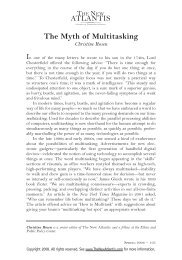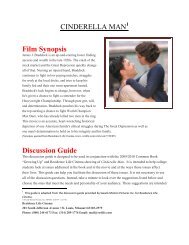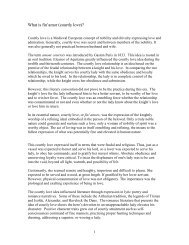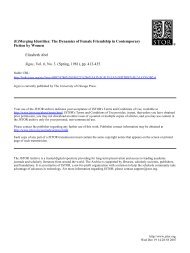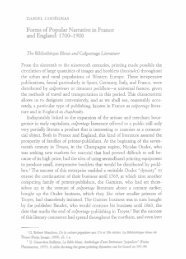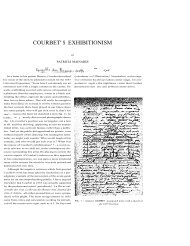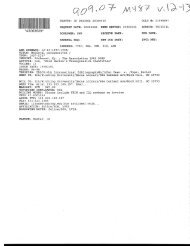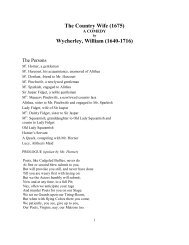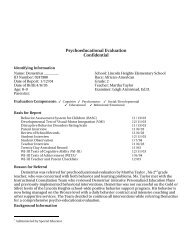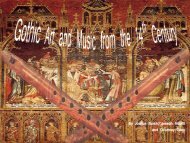CARRIE MAE WEEMS - People Search Directory
CARRIE MAE WEEMS - People Search Directory
CARRIE MAE WEEMS - People Search Directory
Create successful ePaper yourself
Turn your PDF publications into a flip-book with our unique Google optimized e-Paper software.
,<br />
each of Weems's portrait-like photographs<br />
serves an important symbolic function<br />
within the framework of social change<br />
proffered by the artist.<br />
In captioning these photographs,<br />
Weems also seems to take the anthropological<br />
view that, as artifacts of culture,<br />
the function of tools can only be fully<br />
known if we understand the society<br />
which created them. To this end, her captions<br />
provide further keys to the meaning<br />
of each object. \Xlhether metaphoric, as in<br />
A Hot Spot in a Corntpt World for a globe,<br />
or metonymic, as in Some Theory for a<br />
partly opened book (plates 38 and 40),<br />
the captions extend the scope of the<br />
work's symbology. A Hot Spot in a<br />
Corrupt World is a particularly rich example.<br />
Here, the term for a bright spot on<br />
the surface of a photograph combines<br />
with a geopolitical description of a troubled<br />
region to pinpoint the northwest<br />
coast of Africa, where the slave trade once<br />
flourished. The image and text thus work<br />
together in a most economical way to<br />
define the root of African American and<br />
Anglo-American race and class problems<br />
as stemming from the corrupt practice of<br />
slavery.<br />
Often as well in And 22 Million.<br />
Weems pairs captioned photographs to<br />
dredge up additional imagery. This can be<br />
seen in A Hammer and And a Sickle,<br />
which pOint directly to the history of the<br />
Communist International, while A Bell to<br />
Ring and A Song to Sing call forth images<br />
of Freedom Riders of the 1960s and the<br />
1950s anthem of the left, Pete Seeger's "If<br />
I Had a Hammer.'·'i6 Whatever the order<br />
and the pairings of captioned photographs,<br />
And 22 Million Very Tired and<br />
Very Angly <strong>People</strong> always seems to be<br />
able to maintain its storied richness. In the<br />
context of the six photographs reproduced<br />
in this catalogue, for example,<br />
combining A Hot ::'pot in a Corrupt World<br />
with Some TheOly, the rolling pin weapon<br />
of By Any Means Necessary, the Orisha<br />
figure in A Little Black ivlagic and the<br />
stances of An Armed Man and A Veiled<br />
Woman (plates 38--43), presents us with a<br />
wide gamut of options for resistance<br />
against the status quo. From revolutionary<br />
writing to a head-splitting rolling pin,<br />
from the bearing of arms to the wielding<br />
of hexes, both men and woman can practice<br />
arts that stand against injustices in a<br />
less than perfect world.<br />
The final level of interpretation which<br />
ties the entire installation together may be<br />
found in the silk-screened banner texts,<br />
which alternate red and white like the colors<br />
of the Soviet flag and touch you lightlyon<br />
the shoulder with their messages as<br />
you walk by. As in the captioned photographs,<br />
the banners suggest a variety of<br />
approaches to effecting change. Whether<br />
it is the common sense of Fannie Lou<br />
Hamer's call to unity, Franz Fanon's<br />
admonition against self-interest, Luisah<br />
Teish's hexing of warmongers or the<br />
philosophical arguments of Karl Marx and<br />
Friedrich Engels, made new by neo<br />
Marxists Herbert Marcuse or Stuart Hall,<br />
Weems asserts the need for different voices<br />
to join together and be heard.<br />
Indeed, the thinker who sums up<br />
Weems's approach to social change is<br />
Italian Marxist-pragmatist Antonio<br />
Gramsci, or, perhaps more specifically,<br />
Gramsci on the dismantling of racist social<br />
constructs, as interpreted by Stuart Hall."9<br />
Not coincidentally, it is Gramsci's quotation<br />
from the Prison Notebooks which<br />
appears in conjunction with Weems's<br />
photograph of Some Theory (plate 40)<br />
"Every individual is not only the synthesis<br />
of contemporary relationships, he is also a<br />
summary of the entire past. It may be<br />
objected that what each individual can<br />
change is very little This is true up to a<br />
point. But since each person can join others<br />
who want the same changes, he can<br />
multiply himself an imposing number of<br />
times. If the change desired is 'rational,'<br />
historically possible, then even a very radical<br />
change can be achieved, one that did<br />
not seem possible at first sight."<br />
In Weems's overarching belief in the<br />
historical possibility of full recognition for<br />
African Americans as constitutive, rather<br />
than additive, parts of American life, the<br />
artist professes her belief in Gramsci's<br />
ideas:<br />
-that, power structures are not monolithic<br />
but rather are historically and culturally<br />
specific;<br />
-that, everyone can be a philosopher or<br />
intellectual in so far as he or she thinks;<br />
-that, common sense, like folklore, is<br />
31




